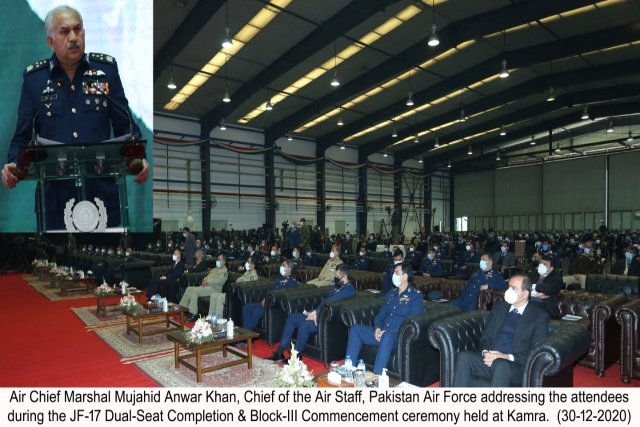Pakistan has launched local production of JF-17 Block III fighter aircraft, the most advanced variant of the JF-17 it developed along with China.
“In-country production of JF-17 Block-3 formally launched by Air Chief Marshal Mujahid Anwar Khan, Chief of the Air Staff, PAF at Pakistan Aeronautical Complex (PAC) Kamra today,” Pakistan Air Force announced on December 30.
The occasion also witnessed roll out of dual-seat JF-17B aircraft for Pakistan Air Force (PAF). PAC Kamra rolled out the first batch of eight dual-seat JF-17 aircraft on December 27 last year.Pakistani media reported that the service inducted 14 JF-17Bs Wednesday.
The occasion was attended by Ambassador of Peoples’ Republic of China in Pakistan, H.E. Mr. Nong Rong. He highlighted JF-17 as a shining example of cooperation between two countries over the last two decades for a joint venture from drawing board to successful materialization. He assured of China's continued support for ongoing & future joint ventures in all domains.
New in the the Block III version is an active electronically scanned array (AESA) radar, helmet-mounted targeting system, an advanced targeting pod, data links and beyond visual range weapons. The jet also packs information-based warfare capability and upgraded weapons.
In July, Russia confirmed it is working on a new engine, RD-93MA, which is an upgraded version of RD-93 used on the JF-17. This engine can produce maximum thrust of 9,300 kgf, more when compared to RD-93’s maximum thrust of 8,300kgf. It is not yet clear if this engine will be shoe-horned into the JF-17.
KLJ-7A AESA radar for JF-17 Block III
The PAF has selected the KLJ-7A active electronically scanned array (AESA) radar for the JF-17 Block-III, unconfirmed reports said in early 2020.
Developed by the Nanjing Research Institute of Electronics Technology (NRIET), the KLJ-7A was revealed in 2016 as a potential option for the JF-17. The sales brochure released by NRIET says that the KLJ-7A offers a maximum range of 170 km against a target with a radar cross-section (RCS) of 5m2. NRIET added that the KLJ-7A uses over 1,000 transmit/receive modules (TRM), and is capable of tracking 15 targets and simultaneously engaging four.It also has over 11 modes for operation, including synthetic aperture radar which will allow it to see through clouds.
ASELPOD Targeting System for JF-17
Turkish firm Aselsan has signed a $24.9 million contract with Pakistan in 2017 to integrate its ASELPOD Electro Optical Targeting System onto JF-17 fighter jets. While these are said to be used on the JF-17 Block II, it is not confirmed if the pods will be used on the Block III as well.
The PAF also has the option of Chinese targeting pods- WMD-7 and OC2. It is not known if these have superior features over the ASELPOD.Earlier, Pakistan tried unsuccessfully to obtain the Damocles targeting pod from France. However, with the advent of the Talios targeting pod on the Indian Rafale, considered more advanced than the Damocles, the response of the PAF on what targeting sytem to put on the JF-17 Block III remains to be seen.





